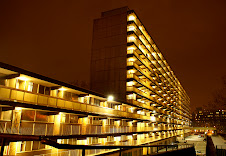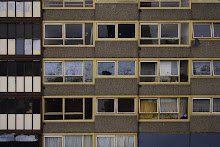
Yesterday when I came home the welders were working in on three or four flats all over the building. The reverb from their generators shook through the walls like they were working right next door. When I went out, I watched them from platform four of the train station – the arc welders working three at a time putting up the big plates of iron, the blue welder’s flame flashing like sparkles from the gangways, a trio of council officals wandering in and out of the flats that had already been blocked off by the grey iron doors.
Soon, these iron bands will block off a third, then a half of Claydon House, just like they block off a third of that huge estate I see out the window. How will it be when the whole estate is empty but for one or two holdouts? How would it be occupy a single flat in a building this vast, to feel the emptiness spreading out through the building at night, to walk down gangways past sealed off flats, knowing no one else’s steps will tread the concrete stairwells – to know the building will soon be rubble?
For now, people are coming out again to enjoy the light evenings. Kids on the gangways, the Africans and Latinos who seem to make up most of the Heygate’s residents feeding on and off the rampways. Two young English girls, hair back in those ponytails young English girls seem to favour, one of them pushing a baby carriage with that stolid efficiency of young English single moms, as if having a baby has fulfilled their duty in life . . .the friend chattering and breaking into random dance moves – hip-hop hand gestures, a more obvious 80’s style sway of her hips and legs; the robot – moving as if to music only she can hear, describing to her friend through motion what is playing in her head.






